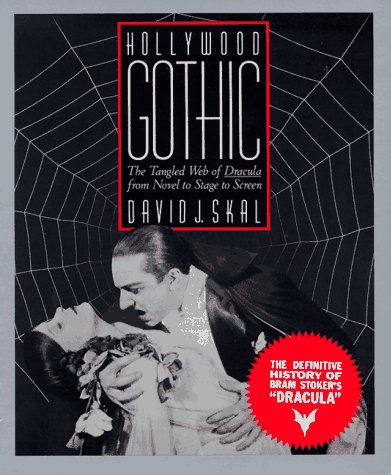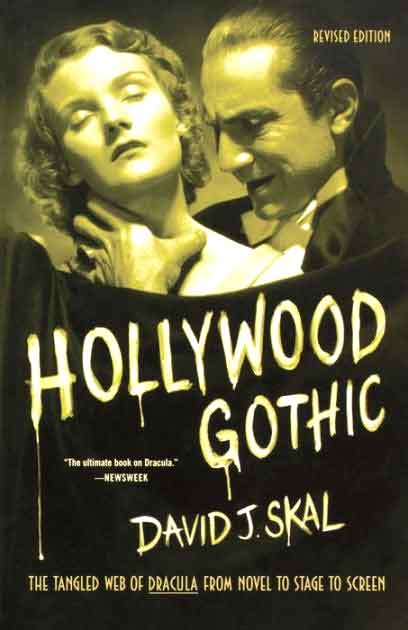By DAVID J. SKAL (W.W. Norton & Company; 1990)
In which author David J. Skal made his first stab at nonfiction. He’s now known for film commentary, but back in 1990 Skal’s literary output consisted of three strong but little-read science fiction novels, meaning the back cover blurb praising his “novelist’s eye” is entirely accurate.
…back in 1990 Skal’s literary output consisted of three strong but little-read science fiction novels, meaning the back cover blurb praising his “novelist’s eye” is entirely accurate.
HOLLYWOOD GOTHIC was an ambitious undertaking: an examination of Bram Stoker’s immortal DRACULA and its bumpy road to pop culture immortality (Dracula being a figure, Skal claims, whose “recognition factor probably rivals, in its own perverse way, the familiarity of Santa Claus”). HOLLYWOOD GOTHIC’S focus is on the novel and its early film adaptations: F.W. Murnau’s NOSFERATU, Todd Browning’s DRACULA and the Spanish language remake.
Dracula being a figure, Skal claims, whose “recognition factor probably rivals, in its own perverse way, the familiarity of Santa Claus”
Covered, in elegant and erudite prose, is Stoker’s life in the shadow of Henry Irving, for whom Stoker worked as manager of London’s Lyceum Theatre. (Skal, FYI, later wrote a standalone biography of Stoker.) DRACULA proved the most successful of Stoker’s handful of novels, and single-handedly sustained his widow Florence in the decades following his 1912 demise.
So reliant was Florence Stoker on the “steady, if skimpy and unpredictable, income” brought by DRACULA that she launched an extensive legal attack on NOSFERATU (1922), an unauthorized German adaptation of her husband’s work. Skal’s novelistic bent is particularly evident in his descriptions of Florence Stoker’s crusade: “She was old, but still quite handsome, and though her own eyesight was failing badly, others could see very well the warrior-saint profile that had pleased (artist Edward) Burne-Jones. At the age of 64 she was being called upon to live up to this faded image.”
Covered, in elegant and erudite prose, is Stoker’s life in the shadow of Henry Irving, for whom Stoker worked as manager of London’s Lyceum Theatre. (Skal, FYI, later wrote a standalone biography of Stoker.)
To stay afloat Ms. Stoker commissioned the production of a not-very-good theatrical adaptation of DRACULA. Shockingly, the play became a sizeable hit, and led to the Tod Browning directed DRACULA (1931). Skal co-authored a 1995 biography of Browning, but here he’s quite dismissive of the man’s filmic output, claiming that “more often than not the Browning end product is an unholy mess”—which is, more or less, Skal’s assessment of Browning’s DRACULA. Of the film’s star, Skal claims Bela Lugosi got the title role (which he’d previously essayed onstage) because several bigger names passed on it, and also because Lugosi had offered to do the part for an absurdly cheap fee (never a wise negotiating tactic).
Skal claims Bela Lugosi got the title role (which he’d previously essayed onstage) because several bigger names passed on it, and also because Lugosi had offered to do the part for an absurdly cheap fee (never a wise negotiating tactic).
Skal is far more generous in his coverage of the Spanish language DRACULA that was filmed concurrently with Browning’s version. This book marked the first in-depth English language accounting of the Spanish DRACULA, and Skal made the most of that fact, extensively interviewing the film’s star Lupita Tovar and traveling to Cuba, the location of what in 1990 was the film’s sole uncut print.
The final chapters contain an overview of the many cinematic DRACULA offshoots (DRACULA: PRINCE OF DARKNESS, Werner Herzog’s NOSFERATU, John Badham’s DRACULA, etc.) and a chronology of noteworthy DRACULA-related events that culminates with the publication of this book. An author listing his own book in a historical chronology may seem the height of arrogance, but I say HOLLYWOOD GOTHIC’S inclusion in that chronology is entirely justified, as time has proven it a vitally important, and even crucial, component of the DRACULA saga.


